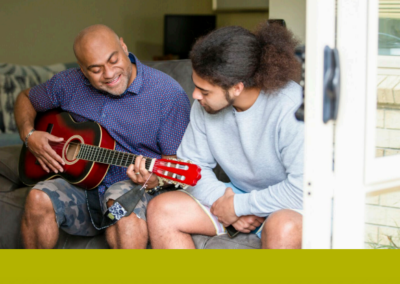Case Study_Monte Cecilia_FINAL



Paul Majurey, of Marutūāhu descent, chairs the Waimahia and Puhinui Park community housing developments.
This was brought together by the Tāmaki Collective of iwi, NZ Housing Foundation, CORT Community Housing and Te Tumu Kainga (the Māori Trustee). Importantly, the development was given its Waimahia name by Te Ākitai Waiohua, mana whenua of the area.
The vision of the partners was for a strong community living in warm houses among open spaces and parks with no discernible markers between social/affordable and privately owned homes. The Waimahia community includes 48% Māori and 18% Pacifica. There is a large number of youth (29% are under 15 years of age and nearly 50% are 25 and under) together with kaumātua. Next year, an early childhood centre will be completed, funded by the Waimahia partnership, which will also be available to the community in the evenings and weekends. Significantly, there is an active and cohesive community group.
The project was announced in late 2013 and its unusual features quickly made headlines. Rather than originating from a state agency or national housing corporate, the affordable housing proposal was the initiative of a partnership of iwi and not-for-profit community housing providers. With a then projected 283 single-lot units consisting of a high proportion of affordable homes, it was a rare example of scale affordable housing amid a growing housing affordability crisis. Rather than another example of land banking or quick-flick capital gain projects in Auckland, investors were shown the door in favour of first-home families who wanted a place to grow together with their children.
The project involved a number of firsts. It was the first large-scale Crown land opportunity taken up by the 13 iwi/hapū of the Tāmaki Collective (being the tribes of Waiohua, Ngāti Whātua and Marutūāhu) under their landmark Treaty settlement. It was the first time Auckland community housing providers (Housing Foundation and CORT Community Housing) partnered together for a scale project. It was the launching pad for the first national Māori community housing provider – Te Tumu Kainga. It was the first designated Auckland special housing area; the first to obtain resource consents under the SHA legislation; and the first to begin house construction. The support of Auckland Council and the Manurewa Local Board was crucial.

Tāmaki Collective, consisting of the tribes of Waiohua, Ngāti Whātua and Marutūāhu, are nearing completion of the Waimahia housing development.
The first families moved into their new homes in September 2014, 11 months after the announcement of the project. The 295 houses range from two to five bedrooms and are architect-designed, with double glazed windows and have a five-star energy rating.
Of the 70% of non-private homes, 29% are in a shared equity scheme, 20% in a rent-to-buy scheme, 2% in long-term community rental, and 18% in ownership by the community housing providers for their tenants. The late-2013 prices were $350,000 for a two-bedroom house, $394,000 for a three-bedroom house, $455,000 for a four-bedroom house and five-bedroom house from $500,000. Homes sold in the last stages ranged from $635,000 (three bedrooms) to $680,000 (four bedrooms).
The above summary belies the challenges and courage shown by all involved. This $120 million project would not have occurred without the government’s decision, against officials’ advice, to provide $29 million of funding to an iwi-community partnership which had never built a house together. Nor would anyone have passed go without the Tāmaki Collective partnering with the community housing providers to take up a Treaty settlement opportunity. Each of the providers put up scarce money in their singular drive to provide homes for families. Finally, brave decisions were made by whānau to buy or rent off the plans.
In the end more homes were built than planned, and surplus funds have, with government support, been recycled into the next community housing project at Manukau (the Puhinui Park Project). Most satisfying of all, however, is the enduring community living together at Waimahia.
We hope this is a model which the new coalition government can seize upon and really scale up, as it looks to deliver on its commitments to ease the housing affordability crisis – a crisis which particularly affects low-income families, in which Māori are over-represented.
We think there’s clearly a real will to solve these problems. Waimahia shows the way.
Community Housing Aotearoa - Newsletter 3 June 2025
Community Housing Aotearoa_Media Release_Unlocking affordability key to ending homelessness_2025
Westpac NZ And Community Housing Aotearoa Announce New Partnership